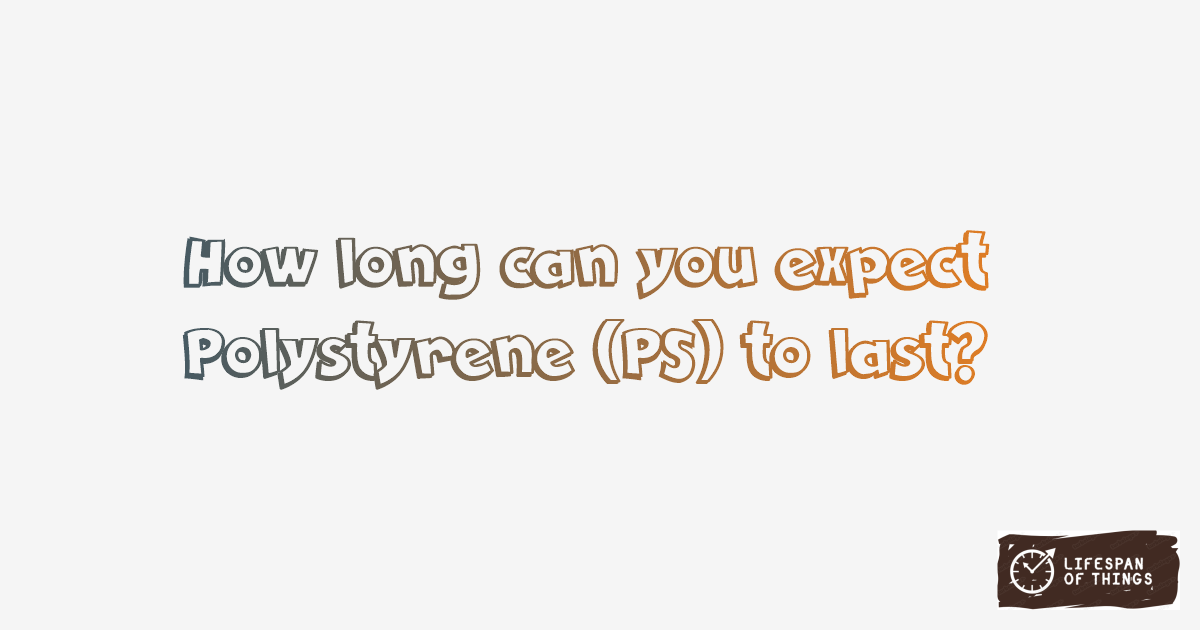
100 - 1000 Years
Lifespan of Polystyrene (PS) is 100 - 1000 Years. Polystyrene (PS) longevity is influenced by factors like exposure to sunlight, temperature changes, and chemical interactions. Proper storage and handling can help extend the lifespan of Polystyrene (PS).
Useful Information
Polystyrene (PS) exhibits properties such as lightweight, rigid structure, and good thermal insulation. Different types include expanded polystyrene (EPS) and extruded polystyrene (XPS) with varying densities and application suitability.
Polystyrene (PS) finds use in packaging, insulation, and consumer goods like disposable utensils and CD cases. Its versatility extends to construction as insulation boards and in the medical field for disposable syringes.
Polystyrene (PS) durability can be affected by exposure to heat, moisture, and solvents. Factors like UV radiation and mechanical stress can impact its lifespan. To enhance durability, store Polystyrene (PS) away from direct sunlight and extreme temperatures.
The production and disposal of Polystyrene (PS) can have environmental consequences like non-biodegradability and potential leaching of chemicals. Sustainable alternatives like biodegradable polystyrene offer eco-friendly choices to reduce environmental impact.
Embrace eco-friendly alternatives like biodegradable plastics and recycled materials to reduce the environmental impact of thermoplastics production and usage. Read more
To care for Polystyrene (PS), avoid direct contact with harsh chemicals and clean with mild soap and water. Proper handling during storage can prevent breakage and extend its lifespan. Regular maintenance and repairs can help preserve the appearance and functionality of Polystyrene (PS).
Lifespan Comparisons
| Compared Item | Comparison Description |
|---|---|
| Lifespan of Polyethylene (PE) | Polystyrene (PS) and Polyethylene (PE) have a similar lifespan spanning several centuries, ensuring long-term durability. |
| Lifespan of Polypropylene (PP) | Compared to Polypropylene (PP), Polystyrene (PS) lasts significantly longer, making it a more sustainable material choice. |
| Lifespan of Polyvinyl Chloride (PVC) | Polyvinyl Chloride (PVC) has a lifespan shorter than Polystyrene (PS) but longer than many other materials, offering a balance of durability. |
| Lifespan of Polyethylene Terephthalate (PET) | Polystyrene (PS) and Polyethylene Terephthalate (PET) share a similar longevity, ensuring products made from these materials remain intact for centuries. |
| Lifespan of Platinum | Polystyrene (PS) outlasts precious metals like Platinum in terms of lifespan, providing a stable material for various applications. |
| Lifespan of Palladium | Unlike Palladium, Polystyrene (PS) has a much longer lifespan, making it a reliable choice for long-lasting products. |
| Lifespan of Rhodium | Rhodium and Polystyrene (PS) share a similar lifespan, offering durable options for different purposes. |
| Lifespan of Tungsten | Tungsten and Polystyrene (PS) have comparable lifespans, ensuring reliability in their respective applications over extended periods. |
| Lifespan of Dead Sea Scrolls | Polystyrene (PS) may not last as long as the Dead Sea Scrolls, but it provides a durable solution for modern-day products. |
| Lifespan of Rosetta Stone | While not as ancient as the Rosetta Stone, Polystyrene (PS) offers longevity suitable for various contemporary uses. |
| Lifespan of Magna Carta | Compared to historical documents like the Magna Carta, Polystyrene (PS) ensures products maintain their integrity for a significant period. |
| Lifespan of Epic of Gilgamesh Tablets | Polystyrene (PS) may not rival the age of the Epic of Gilgamesh Tablets, but it provides enduring quality for modern applications. |
| Lifespan of Declaration of Independence | For products meant to last, Polystyrene (PS) offers a longer lifespan compared to the Declaration of Independence. |
| Lifespan of Terracotta Army | Polystyrene (PS) may not match the longevity of the Terracotta Army, but it provides durability suitable for various items. |
| Lifespan of Pompeii Ruins | While Pompeii Ruins have stood for centuries, Polystyrene (PS) offers a reliable lifespan for modern-day materials. |
Frequently Asked Questions
Lifespan of Polystyrene (PS) is 100 - 1000 Years.
Factors like exposure to heat, moisture, UV radiation, and mechanical stress can impact the durability of Polystyrene (PS).
Polystyrene (PS) can be used in construction for insulation boards due to its thermal properties and lightweight nature.
Biodegradable polystyrene offers a sustainable alternative to traditional Polystyrene (PS) by reducing environmental impact.
To care for Polystyrene (PS), avoid harsh chemicals and clean with mild soap and water to preserve its appearance and functionality.
Expanded polystyrene (EPS) and extruded polystyrene (XPS) differ in their densities and suitability for various applications due to their manufacturing processes.








